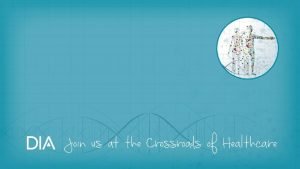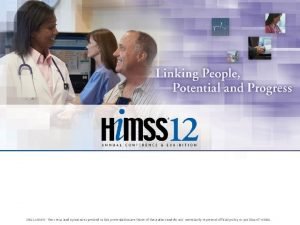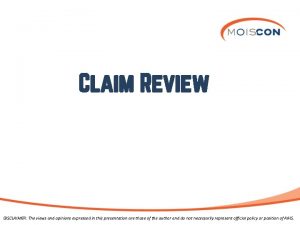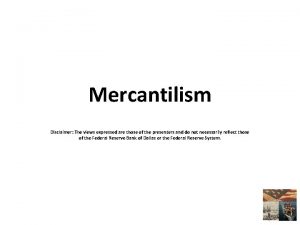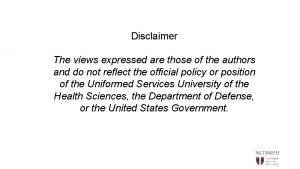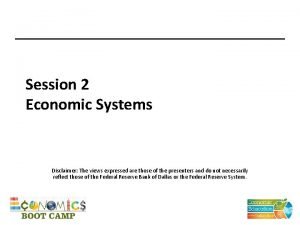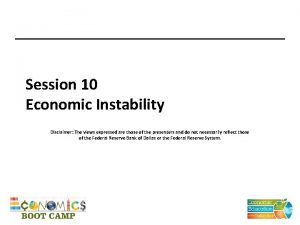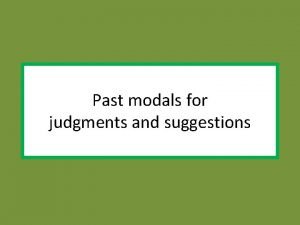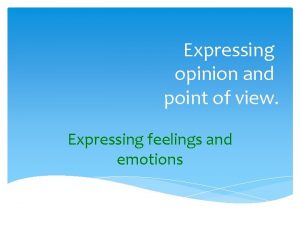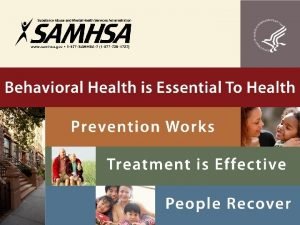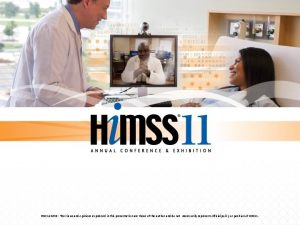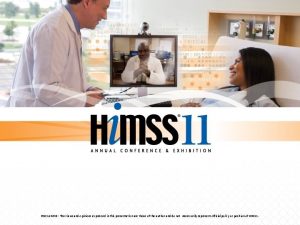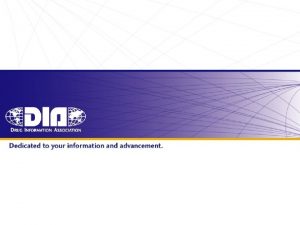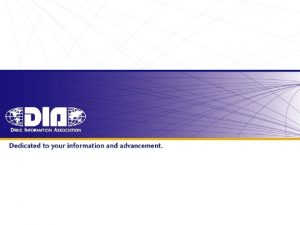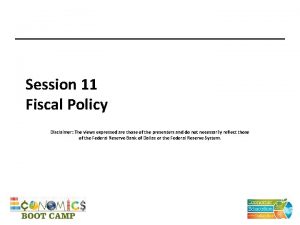DISCLAIMER The views and opinions expressed in this































































- Slides: 63

DISCLAIMER: The views and opinions expressed in this presentation are those of the author and do not necessarily represent official policy or position of HIMSS.

Conflict of Interest Disclosure James L. Holly, MD CEO, Southeast Texas Medical Associates, LLP Has no real or apparent conflicts of interest to report. © 2012 HIMSS

1. Analyze the process of a desired outcome by designing and deploying an IT solution to support Care Transitions from inpatient hospital to ambulatory care 2. Demonstrate how IT solutions can aide in dealing with barriers to care in the transition from hospital to ambulatory care 3. Demonstrate the place of care coordination in Care Transitions 4. Demonstrate the place of auditing of performance in sustaining effective care transitions 5. Demonstrate the place of a healthcare delivery team in an IT solution to care transitions.

Care Transitions: The Heart of Patient-Center Medical Home 4

Care Transitions In SETMA’s Model of Care -- Care Transition involves: 1. Evaluation at admission -- transition issues : “lives alone, ” barriers , DME, residential care, or other needs 2. Fulfillment of PCPI Transitions of Care Quality Metric Set 3. Hospital Care Summary and Post Hospital Plan of Care and Treatment Plan 4. Post Hospital Follow-up Coaching -- a 12 -30 minute call made by members of SETMA’s Care Coordination Department and additional support 5. Follow-up visit with primary provider 5

National Priorities Partnership National Quality Forum Input to the Secretary of HHS Priorities for the 2011 National Quality Strategy • Wellness and Prevention • Safety • Patient and Family Engagement • Care Coordination • Palliative and End of Life Care 6

National Priorities Partnership Addressing the fourth NPP goal, the NQF report to HHS stated that in regard to care coordination: “Healthcare should guide patients and families through their healthcare experience, while respecting patient choice, offering physical and psychological supports, and encouraging strong relationships among patients and the healthcare professionals accountable for their care…. ” 7

National Priorities Partnership Focus in care coordination by NPP are the links between: • Care Transitions— …continually strive to improve care by … considering feedback from all patients and their families… regarding coordination of their care during transitions between healthcare systems and services, and…communities. • Preventable Readmissions— …work collaboratively with patients to reduce preventable 30 -day readmission rates. 8

Care Transitions & Hospital Readmission In SETMA’s experience, there are fifteen steps required to address care coordination and hospital readmissions, as a function of a quality care initiative which is sustainable. The steps and the solution for each are as follows. 9

Care Transitions & Hospital Readmission 1. In January, 1999, SETMA began using the EHR to document patient encounters. In May, 1999, SETMA modified the goal to electronic patient management (EPM) in order to leverage the power of electronics to improve treatment outcomes. In October, SETMA began using the EMR in the hospital for hospital H&Ps, creating continuity-ofcare process, based on healthcare data being electronically created and being available at all points of care. 10

Care Transitions & Hospital Readmission 2. In 2000, realizing that excellent care in the 21 st Century was going to be team-based, SETMA formed a hospital service team, which provides 24 -hour-a-day, seven-day a week, in-house coverage for all of our patients. 11

Care Transitions & Hospital Readmission 3. In 2001, SETMA began using the EHR to produce hospital discharge summaries which further advanced continuity-of-patient-care and established the groundwork both for care transitions and for effectively addressing preventable readmissions. At this point, medication reconciliation could take place in the: clinic, hospital, nursing home, home health and emergency department. 12

Care Transitions & Hospital Readmission 4. In 2003, SETMA designed hospital-admissionorder sets, based on national standards of care, which created a consistency of treatment plans and eliminated delay in the initiation of excellent care. 13


Care Transitions & Hospital Readmission 5. Also , in 2003, SETMA began using the EHR in all twenty-two nursing homes we staff. Because our patients’ care is managed in the same electronic data base, whether in the ambulatory setting, hospice, home health, physical therapy, hospital, emergency department, or nursing home, there is a continuity-of-care which is data and information driven. 15

Care Transitions & Hospital Readmission 6. In 2004, SETMA designed an electronic, Inpatient Medical Record Census (IMRC); deployed on SETMA’s intranet and HIPPA compliant, the IMRC allows searchable-data recording of: a. b. c. d. e. date of admission to the hospital place of admission date and time of completion of the History and Physical date of discharge date and time of completion of the Hospital Care summary and post-hospital plan of care and treatment plan. f. Posting of questions from business office which need research 16 by hospital care team.


Care Transitions & Hospital Readmission 7. In 2007, SETMA’s partners realized that many of our patients, even those with insurance, cannot afford all of their health care. This resulted in the creation of The SETMA Foundation. SETMA partners have given over $1, 500, 000 to the Foundation which pays for medications, surgeries and other care, such as dental, for our patients who cannot afford it. 18

Care Transitions & Hospital Readmission 8. In June, 2009, the Physician Consortium for Performance Improvement (PCPI) published the first national quality measurement set on Care Transitions; the same month, SETMA deployed the measures in our EHR. Since then, of the 25, 995 discharges from the hospital, 99. 1% have had the Hospital Care Summary completed at the time the patient left the hospital. 19

Care Transitions & Hospital Readmission 9. October, 2009, SETMA adapted a Business Intelligence tool to create an audit of hospitalized patients to examine differences between patients who are re-admitted and those who are not. The audit looks at: gender, ethnicity, socio-economic issues, social isolation, morbidities and comorbidities, lengths of stays, age, timing of followup after discharge, whether a follow-up call was received and other issues. These measures look for leverage points for “making a change, which 20 will make a difference in readmissions”

Care Transitions & Hospital Readmission 10. November, 2009, SETMA began publicly reporting performance on over 200 quality metrics by provider name at www. jameslhollymd. com. Disease management plans-of-care documents for diabetes, hypertension, and cholesterol, include the provider performance on that patient’s care, as judged by these quality metrics. 21


Care Transitions & Hospital Readmission 11. In July, 2010, pursuant to becoming a Tier 3 PCMH, SETMA created a Department of Care Coordination, which is tasked with: • • Post Hospital follow-up calling Completing SETMA Foundation Referrals Patient counseling for barriers to care Establishing continuity of care Engaging patients in their own care Alerting providers to patients’ special needs Another level of mediation reconciliation 23

Care Transitions & Hospital Readmission 12. September, 2010, at a National Quality Forum workshop on Care Transitions, SETMA realized that the term “discharge summary” was outdated. We changed the name to “Hospital Care Summary and Post Hospital Plan-of-Care and Treatment-Plan, ” long and perhaps awkward, this name, is functional, focusing on the unique elements of Care Transition which contribute to the foundation for a sustainable plan for addressing preventable readmissions to the hospital. 24

Care Transitions & Hospital Readmission 13. In 2010, SETMA deployed both a secure web portal and a health information exchange to allow the seamless exchange of information between the hospitals, nursing homes, home health agencies, hospices, and SETMA. The HIE has been expanded to a seven-county project including all healthcare providers and agencies, which will ultimately be the key to preventing readmission to the hospital. 25

Care Transitions & Hospital Readmission 14. Since 1997, SETMA has partnered with a Medicare Advantage home health agency, with other home health agencies and with freestanding hospices to provide compassionate, competent care for our patients in settings other than hospital inpatient to reduce readmissions of our most vulnerable patients while providing excellent care to them. 26

Care Transitions & Hospital Readmission 15. As a Patient-Centered Medical Home, SETMA makes certain that the Hospital Care Summary and Post Hospital Plan of Care and Treatment is transmitted to the next site of care as the “baton, ” (see below). With these care coordination, continuity of care and patientsupport functions, SETMA believes that we are ready to make a major effort to decrease preventable readmissions to the hospital. 27

Care Transitions & Hospital Readmission Since June, 2009, SETMA has discharged 25, 995 patients from the hospital with a 99. 1 efficiency of presenting a Hospital Care Summary and a Post Hospital Plan of Care and Treatment Plan to the patient, family or care giver at the time of discharge. Since August, 2010, all patients have received a 12 -30 minute care-coaching follow-up call the day following discharge from the hospital. In that time, we have experienced a 22% decrease in preventable readmissions to the hospital. 28

Care Transitions In SETMA’s Model of Care -- Care Transition involves: 1. Evaluation at admission -- transition issues: “lives alone, ” barriers, DME, residential care, or other needs 2. Fulfillment of PCPI Transitions of Care Quality Metric Set 3. Post Hospital Follow-up Coaching -- a 12 -30 minute call made by members of SETMA’s Care Coordination Department and additional support 4. Plan of Care and Treatment Plan 5. Follow-up visit with primary provider 29

Hospital Care Summary SETMA’s Hospital Care Summary is a suite of templates with which the transition of care document Is created. (A full tutorial of these templates can be found on our website at www. jameslhollymd. com under “Electronic Patient Tools” at “Hospital Based Tools. ”) The following is a screen shot of the Master Discharge Template entitled “Hospital Care Summary”. This screen shot is from the record of a real patient whose identify has been removed. 30

Hospital Care Summary 31

Care Transition Audit At the bottom of this template, there is a button Entitled “Care Transitions Audit. ” Once the suite of Templates associated with the Hospital Care Summary has been completed, the provider depresses this button and the system automatically aggregates the data which has been documented and displays which of the 18 -data points have been completed and which have not. 32


Care Transition Audit The elements in black have been completed; any in red have not. If an element is incomplete, the provider simply clicks the button entitled “Click to update/Review. ” The missing information can then be added. This fulfills one of SETMA’s principles of EHR design which is “We want to make it easier to do it right than not to do it at all. ” 34

Care Transition Audit Quarterly and annually, SETMA audits each provider’s performance on these measures and publishes that audit on our website under “Public Reporting, ” along with over 200 other quality metrics which we track routinely. The following is the care transition audit results by provider name for 2011. 35

Care Transition Audit 36

Care Transition Audit 37

Hospital Care Summary Once the Care Transition issues are completed, The Hospital Care-Summary-and-Post- Hospital-Plan-of Care-and Treatment-Plan document is generated and printed. It is given to the patient and/or to the patient’s family and to the hospital. 38

The Baton The following picture is a portrayal of the “plan of care and treatment plan” which is like the “baton” in a relay race. 39

The Baton “The Baton” is the instrument through which responsibility for a patient’s health care is transferred to the patient or family. Framed copies of this picture hang in the public areas of all SETMA clinics and a poster of it hangs in every examination room. The poster declares: Firmly in the provider’s hand --The baton -- the care and treatment plan Must be confidently and securely grasped by the patient, If change is to make a difference 8, 760 hours a year. 40

The Baton The poster illustrates: 1. That the healthcare-team relationship, which exists between the patient and the healthcare provider, is key to the success of the outcome of quality healthcare. 2. That the plan of care and treatment plan, the “baton, ” is the engine through which the knowledge and power of the healthcare team is transmitted and sustained. 3. That the means of transfer of the “baton, ” which has been developed by the healthcare team, is a coordinated effort between the provider and the patient. 41

The Baton 4. That typically the healthcare provider knows and understands the patient’s healthcare plan of care and the treatment plan, but without its transfer to the patient, the provider’s knowledge is useless to the patient. 5. That the imperative for the plan – the “baton” – is that it must be transferred from the provider to the patient, if change in the life of the patient is going to make a difference in the patient’s health. 42

The Baton 6. That this transfer requires that the patient “grasps” the “baton, ” i. e. , that the patient accepts, receives, understands and comprehends the plan, and that the patient is equipped and empowered to carry out the plan successfully. 7. That the patient knows that of the 8, 760 hours in the year, he/she will be responsible for “carrying the baton, ” longer and better than any other member of the healthcare team. 43

Hospital Follow-Up Call After the care transition audit is completed and the document is generated, the provider completes the Hospital-Followup-Call document: 44

Follow-Up Call • During that preparation of the “baton, ” the provider checks off the questions which are to be asked the patient in the follow-up call. • The call order is sent to the Care Coordination Department electronically. The day following discharge, the patient is called. • The call is the beginning of the “coaching” of the patient to help make them successful in the transition from the inpatient setting. 45

Follow-Up Call • The Care-Coordination, post-hospital call takes 1230 minutes with each patient and engages the patient in eliminating barriers to care. • If appropriate, an additional call is scheduled at an appropriate interval. • If after three attempts, the patient is not reached by phone, the box in the lower left-hand corner by “Unable to Call, Letter sent” is checked. Automatically, a letter is created which is sent to 46 the patient asking them to contact SETMA.

Coordinated Care The genius and the promise of the Patient-Centered Medical Home are symbolized by the “baton. ” Its display continually reminds the provider and will inform the patient, that to be successful, the patient’s care must be coordinated, and must result in coordinated care. In 2011, as we expand the scope of SETMA’s Department of Care Coordination, we know that the principal failure-points of coordination are at the “transitions of care, ” and that the work of the healthcare team – patient and provider – is that together they evaluate, define and execute a plan which is effectively transmitted to the patient. 47

Transition of Care The complexity of the Transition of Care process is illustrated by this analysis of the eight different places this document can need to be sent. 48

Hospital Care Summary 1. Inpatient to ambulatory outpatient (family) – The "baton, " in a printed format, is given to the patient or in the case of a minor or incompetent adult to a parent or care giver. The "plan of care and treatment plan" -- "the baton" -- is reviewed with the patient, parent and/or family before the patient leaves the hospital. 49

Hospital Care Summary 2. Inpatient to ambulatory outpatient (clinic physician) – for patients who are seen at SETMA, the "baton" is created in the EHR and is immediately accessible to the follow-up provider. 50

Hospital Care Summary 3. Inpatient to ambulatory outpatient (follow-up call) -- after the Hospital Care Summary and Post Hospital Plan of Care and Treatment Plan is completed, a secure e-mail is sent to the department of Care Coordination scheduling the post-hospital, follow-up call and letting the caller know the issues which need to be addressed. 51

Hospital Care Summary 4. Emergency Department to ambulatory care – the same process as in "1" above. 5. Inpatient to Nursing Home -- the "baton, " with a special set of Nursing Home orders, is given to the patient or family, and a copy is sent to the Nursing Home with transportation of the patient to the Nursing home. 6. Inpatient to Hospice -- the same as with number “ 5“ 7. Inpatient to Home Health -- the same as number "5“ and "6" above. If the patient is seeing SETMA's home health, they have access to SETMA EHR and thus to the "baton. " 52

Hospital Care Summary 8. Inpatient to outpatient out of area -- "Baton" given to patient and family and also posted to web portal and HIE. token sent to health provider in remote location area, which allows one time access to this patient's information. 53

Follow-Up Visit The Transition of Care is complete when the patent is seen by the primary care provider in follow-up. • Many issues are dealt with in this follow-up visit, but one of them is another potential referral to the Care Coordination Department. If the patient has any barriers to care, the provider will complete the following template. • In this case, with checking three buttons, the need for financial assistance with medications and transportation is communicated to the Care Coordination Department. 54

Care Coordination Referral 55

SETMA Foundation Under the Medical Home model the provider has NOT done his/her job when he/she simply prescribes the care which meets national standards. Doing the job of Medical Home requires the prescribing of the best care which is available and accessible to the patient, and when that care is less than the best, the provider makes every attempt to find resources to help that patient obtain the care needed. 56

SETMA Foundation In February 2009, SETMA saw a patient who has a very complex healthcare situation. When seen in the hospital as a new patient, he was angry, bitter and hostile. No amount of cajoling would change the patient’s demeanor. During his office-based, hospital follow-up, it was discovered that the patient was only taking four of nine medications because of expense; could not afford gas to come to the doctor; was going blind but did not have the money to see an eye specialist; could not afford the co-pays for diabetes education and could not work but did not know how to apply for disability. 57

SETMA Foundation He left SETMA with the Foundation providing: 1. All of his medications. The Foundation has continued to do so for the past two years at a cost of $2, 200 a quarter. 2. A gas card so that he could afford to come to multiple visits for education and other health needs. 3. Waiver of cost for diabetes education in SETMA’s American Diabetes Association accredited Diabetes Self Education and Medical Nutrition Therapy program. 4. Appointment to an experimental, vision-preservation program at no cost. 5. Assistance with applying for disability. 58

SETMA Foundation Are gas cards, disability applications, paying for medications a part of a physician’s responsibilities? Absolutely not; but, are they a part of Medical Home? Absolutely! This patient, who was depressed and glum in the hospital, such that no one wanted to go into the patient’s room, left the office with help. He returned six-weeks later. He had a smile and he had hope. It may be that the biggest result of Medical Home is hope. And, his diabetes was treated to goal for the first time in ten years. He has remained treated to goal for the past two years. 59

SETMA Foundation Every healthcare provider doesn’t have a foundation and even ours can’t meet everyone’s needs, but assisting patients in finding the resources to support their health is a part of medical home. 60

SETMA Foundation And, when those resources cannot be found, Medical Home will be “done” by modifying the treatment plan so that what is prescribed can be obtained. The ordering of tests, treatments, prescriptions which we know our patients cannot obtain is not healthcare, even if the plan of care is up to national standards. 61

Hospital Care Summary • With this infrastructure • With this care coordination • With this continuity of care • With these patient support functions SETMA is ready to make a major effort to decrease preventable readmissions to the hospital. 62

Care Transitions & Hospital Readmissions With this vision, SETMA expects to significantly affect hospital preventable re-admission rates over the next two years and to sustain those improvements. Supported by care transitions, coordination of care, medication reconciliation (at multiple points of care) patient safety, quality of care and cost of care will be positively impacted. 63
 The views and opinions expressed disclaimer
The views and opinions expressed disclaimer All views expressed disclaimer
All views expressed disclaimer The views and opinions expressed
The views and opinions expressed The views and opinions expressed
The views and opinions expressed All opinions expressed disclaimer
All opinions expressed disclaimer The views expressed
The views expressed Disclaimer opinions expressed
Disclaimer opinions expressed The views expressed disclaimer
The views expressed disclaimer Views expressed disclaimer
Views expressed disclaimer Views disclaimer
Views disclaimer Disclaimer the views expressed
Disclaimer the views expressed Disclaimer
Disclaimer Feelings and opinions are the “stuff” poetry is made of
Feelings and opinions are the “stuff” poetry is made of On avoiding foolish opinions summary
On avoiding foolish opinions summary Suggestions modals
Suggestions modals Asking opinion example
Asking opinion example Likes and opinions
Likes and opinions Expressing opinions and feelings
Expressing opinions and feelings Giving recommendations and opinions
Giving recommendations and opinions Structure of giving suggestion
Structure of giving suggestion Facts and opinions about pizza
Facts and opinions about pizza Fact statements examples
Fact statements examples Hát kết hợp bộ gõ cơ thể
Hát kết hợp bộ gõ cơ thể Ng-html
Ng-html Bổ thể
Bổ thể Tỉ lệ cơ thể trẻ em
Tỉ lệ cơ thể trẻ em Voi kéo gỗ như thế nào
Voi kéo gỗ như thế nào Thang điểm glasgow
Thang điểm glasgow Alleluia hat len nguoi oi
Alleluia hat len nguoi oi Các môn thể thao bắt đầu bằng tiếng bóng
Các môn thể thao bắt đầu bằng tiếng bóng Thế nào là hệ số cao nhất
Thế nào là hệ số cao nhất Các châu lục và đại dương trên thế giới
Các châu lục và đại dương trên thế giới Công thức tính thế năng
Công thức tính thế năng Trời xanh đây là của chúng ta thể thơ
Trời xanh đây là của chúng ta thể thơ Cách giải mật thư tọa độ
Cách giải mật thư tọa độ 101012 bằng
101012 bằng độ dài liên kết
độ dài liên kết Các châu lục và đại dương trên thế giới
Các châu lục và đại dương trên thế giới Thơ thất ngôn tứ tuyệt đường luật
Thơ thất ngôn tứ tuyệt đường luật Quá trình desamine hóa có thể tạo ra
Quá trình desamine hóa có thể tạo ra Một số thể thơ truyền thống
Một số thể thơ truyền thống Cái miệng nó xinh thế
Cái miệng nó xinh thế Vẽ hình chiếu vuông góc của vật thể sau
Vẽ hình chiếu vuông góc của vật thể sau Nguyên nhân của sự mỏi cơ sinh 8
Nguyên nhân của sự mỏi cơ sinh 8 đặc điểm cơ thể của người tối cổ
đặc điểm cơ thể của người tối cổ V. c c
V. c c Vẽ hình chiếu đứng bằng cạnh của vật thể
Vẽ hình chiếu đứng bằng cạnh của vật thể Phối cảnh
Phối cảnh Thẻ vin
Thẻ vin đại từ thay thế
đại từ thay thế điện thế nghỉ
điện thế nghỉ Tư thế ngồi viết
Tư thế ngồi viết Diễn thế sinh thái là
Diễn thế sinh thái là Dạng đột biến một nhiễm là
Dạng đột biến một nhiễm là Bảng số nguyên tố lớn hơn 1000
Bảng số nguyên tố lớn hơn 1000 Tư thế ngồi viết
Tư thế ngồi viết Lời thề hippocrates
Lời thề hippocrates Thiếu nhi thế giới liên hoan
Thiếu nhi thế giới liên hoan ưu thế lai là gì
ưu thế lai là gì Hươu thường đẻ mỗi lứa mấy con
Hươu thường đẻ mỗi lứa mấy con Sự nuôi và dạy con của hươu
Sự nuôi và dạy con của hươu Hệ hô hấp
Hệ hô hấp Từ ngữ thể hiện lòng nhân hậu
Từ ngữ thể hiện lòng nhân hậu Thế nào là mạng điện lắp đặt kiểu nổi
Thế nào là mạng điện lắp đặt kiểu nổi
